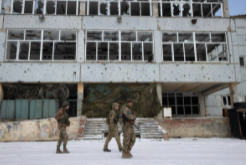By Simon Li
Source: Wikipedia
Russia has amassed an estimated 100 thousand troops along its border with Ukraine in recent months, sparking fears of an invasion in the coming days. According to US intelligence, Russia already has the military capacity to do so and is planning a military offensive in Ukraine in early 2022.
A massive cyberattack on Ukraine on the 14th of January took down dozens of government websites and warned to “be afraid and prepare for the worst”; however, Russia denies any involvement in the attack.
With tensions at an all-time high, Ukraine and Russia have agreed on a permanent ceasefire after more than eight hours of talks in Paris. Further talks are scheduled to take place in the coming weeks. As a result of the heightened tensions, the State Department urged Americans to leave Ukraine and reduced staff levels at the Ukrainian embassy, including family members and nonessential staff.
Putin has released a list of security demands to NATO, including preventing Ukraine from joining NATO and putting a stop on all NATO military activity in central and Eastern Europe. The US has categorically rejected these demands, pursuing instead a “serious diplomatic approach forward” in regards to Ukraine.
In response to the crisis, President Biden has put 8,500 troops on heightened alert for possible deployment in Eastern Europe but has stated that there is “not going to be any American forces moving into Ukraine.” However, Biden has sent $200 million in military aid to Ukraine, including anti-armor systems, grenade launchers, munitions, and Javelins (anti-tank missiles) to Ukraine’s front lines. In addition, Biden warned Putin of “serious economic consequences” if a Russian invasion were to occur.
Russia previously invaded Ukraine in 2014, annexing Crimea in the south of Ukraine. Ever since, it has backed pro-Russian separatist movements in the Eastern regions of Donetsk and Luhansk. Roughly 14 thousand have been killed in these conflicts.
Historically, Ukraine has been a part of Russia; however, with the dissolution of the Soviet Union in 1991, it gained independence. Ever since, the two neighbors have been drifting apart ideologically, with Ukraine wanting closer integration with the West and NATO, while Russia remained staunching anti-West, seeking to retain its sphere of influence over Eastern Europe.
Putin’s goal, ultimately, would be the reunification of Ukraine and Russia, going as far to say that the two nations are “one in the same people” and that to say that Russians are not native to Ukraine is “funny and stupid”. The reunification would allow Russia to access its former industrial powerhouse and finally regain its status as a global superpower.

